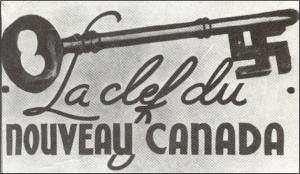6.8 Canadian Fascists
Efforts to transform local movements into national political organizations have generally failed. Ideology provides much stronger glue than localized hostility toward some practice or group. Perhaps one of the hidden benefits of a divided Canadian dualism and pluralism is that it is difficult to muster a mass response to a putative scapegoat group. In times of crisis — like the Great Depression — it becomes possible to mobilize anger and xenophobia as a political movement.
One cannot, therefore, take too lightly the appearance of fascist movements and parties in Canada in the 1930s. Of these, there were three main examples: the Canadian Nationalist Party led by William Whittaker and based in Winnipeg, the Canadian Union of Fascists (a pro-Mosleyite, British fascist organization), and the Parti National Social Chrétien (PNSC). The PNSC was the largest and most successful of the three, the political wing of a Quebec-based fascist movement under the leadership of Adrien Arcand (1899-1967). Heavily influenced by the rise of anti-Semitic movements in Europe and especially by Adolf Hitler’s German National Socialist (Nazi) Party, Arcand was an enthusiastic promoter of an all-white, all-Christian vision of Canada. The PNSC looked beyond the borders of Quebec, seeking sympathizers among Anglo-Canadians under the umbrella of the National Unity Party of Canada (NUPC). The emergence of Ku Klux Klan chapters in Ontario and on the Prairies, as well as the deeply entrenched anti-Asian sentiment among Euro-British Columbians made fertile ground for Arcand’s message. Following on the example set by European fascists, Arcand’s group took to wearing distinctive uniforms festooned with swastikas. While Hitler had his “brown shirts,” Benito Mussolini in Italy his “black shirts,” and Oswald Mosley in Britain his “green shirts,” in Canada the fascists were “blue shirts.”
There is no doubt that Arcand and the NUPC enjoyed some support in Quebec. Even if he was not a member of the NUPC, Montreal’s mayor, Camillien Houde was an outspoken supporter of European fascist powers and hostile to Britain. But the extent of their appeal in the rest of Canada does not seem to have been great. Even the 1938 alliance with Whittaker’s CNP and the creation of the optimistically named National Unity Party could not address the obvious contradiction of a ferociously nationalistic and racist movement that was divided along national and, by their own terms, race lines.[1] Elsewhere in Canada, the half-million ethnic Germans in Canada were divided in their feelings about Hitler’s regime but members of the Deutscher Bund Kanada were vocal, swastika-armband-wearing advocates, particularly of the claims of cultural superiority.

As Europe marched toward a second world war, the Canadian fascists were more closely watched by the state. Having said that, when war was declared and the authorities set about corralling the Whittaker and Arcand parties, their enthusiasm for doing so seems to have been lukewarm. Several facts may explain the tempered response to fascists that contrasts so sharply with police and state commitment to putting down communist movements. First, the authorities and the fascists shared a dislike of the socialists and communists. Second, German settlers enjoyed a largely favourable reputation in Canada, despite the xenophobia stirred up by the Great War, so even ethnic pro-Hitler groups like the Deutscher Bund Kanada might be treated with kid gloves. Third, anti-Semitic sentiments were almost ubiquitous among Catholic and Protestant Canadians so this aspect of fascism did not set off alarm bells.[2] Arcand’s biographer suggests, furthermore, that powerful connections in government kept the party leadership out of jail (at least for a while) and tipped off senior fascists of coming police raids.[3] Arcand, however, spent the war years under guard at Petawawa, a military camp in northern Ontario that served as an internment site for Canadians involved in enemy organizations, including the former mayor of Montreal. Many of the Deutscher Bund similarly wound up interned in New Brunswick for the duration of the war.
Remarkably, the Canadian fascists survived WWII. Arcand ran in elections in 1949 and 1953, finishing second both times with 29% and 39% of the vote respectively. As late as 1965, he could still draw a crowd of 850 to a rally in Montreal’s Paul Sauvé Arena.
Key Points
- As was the case in Britain and across Europe, extremists on the right found support in Canada for fascist movements in the 1930s.
- Support for the fascists was limited but not strongly opposed by the state.
Attributions
Figure 6.16
La clef du nouveau Canada by Jeangagnon is in the public domain.
- Jonathan F. Wagner, Brothers Beyond the Sea: National Socialism in Canada (Waterloo: Wilfrid Laurier University Press, 1981), 76-79. ↵
- Lita-Rose Betcherman, The Swastika and the Maple Leaf: Fascist Movements in Canada in the Thirties (Don Mills: Fitzhenry & Whiteside: 1975), 138-43. ↵
- Jean-François Nadeau, The Canadian Fuhrer: The Life of Adrien Arcand, trans. Bob Chodos, Eric Hamovitch, and Susan Joanis (Toronto: James Lorimer, 2011), 232-3. ↵

